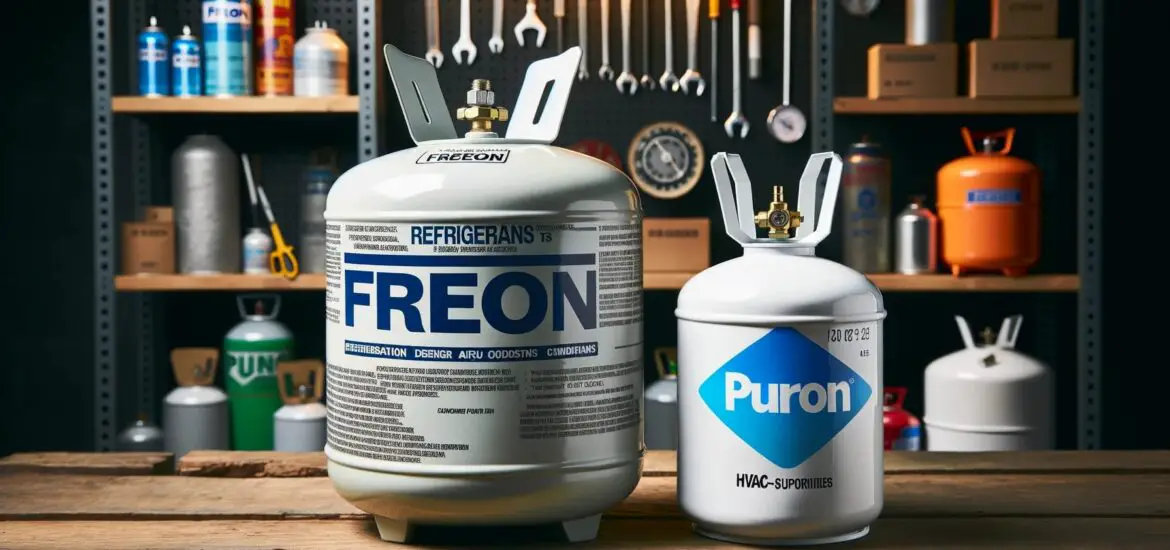In the world of HVAC systems, understanding the difference between Freon and Puron refrigerants is crucial. This article presents an in-depth exploration of these two refrigerants, making the complexities easily digestible for everyone.

Table of Contents
What is Freon?
Freon is not just one substance but a brand name representing a series of refrigerants developed by the Chemours Company. Over the years, several different chemicals have been referred to by the name “Freon”, including chlorofluorocarbons (CFCs), hydrochlorofluorocarbons (HCFCs), and even some hydrofluorocarbons (HFCs). These compounds were chosen for their stability, non-flammability, and effectiveness in the refrigeration cycle.
For many decades, Freon was the industry standard in refrigeration, air conditioning, and aerosol propellants. However, the Montreal Protocol, an international treaty signed in 1987, called for the phasing out of ozone-depleting substances, including many types of Freon.
The reason for this was that certain Freon compounds, when released into the atmosphere, would rise and degrade the ozone layer, resulting in increased UV radiation reaching the Earth and subsequent health and environmental issues.
What is Puron?
Puron, chemically known as R-410A, represents the next generation of refrigerants. Unlike Freon, it is not a brand name but a specific compound. Puron is a blend of two hydrofluorocarbons (HFCs) – difluoromethane and pentafluoroethane. HFCs, such as Puron, were developed as alternatives to ozone-depleting refrigerants.
One of the standout qualities of Puron is that it doesn’t contribute to ozone layer depletion. In addition, it offers several performance benefits, including higher cooling efficiency and the potential for reduced electricity consumption.
However, its high operating pressure means that systems designed for Freon cannot simply be refilled with Puron without significant modifications.
Difference Between Freon and Puron
Freon and Puron, while both serving the role of refrigerants, have distinct differences:
Environmental Impact: The most glaring difference lies in their environmental footprint. Many Freon types, especially CFCs and HCFCs, are known to deplete the ozone layer. Puron, on the other hand, poses no such threat.
Chemical Composition: Freon can be a CFC, HCFC, or HFC, whereas Puron is a specific blend of two HFCs.
Performance: Puron-based systems often deliver better cooling efficiency than their Freon counterparts. This can lead to reduced energy bills for consumers.
Operating Pressures: Puron operates at a higher pressure, which requires specific equipment designs. Simply swapping Freon with Puron in a system without the necessary adjustments can lead to equipment failure.
Transitioning from Freon to Puron
Given the environmental concerns associated with many types of Freon, and the international agreements to phase out its use, there’s a global shift towards alternative refrigerants like Puron. However, transitioning is not as straightforward as it may seem.
First, systems designed for Freon, especially older units, are not compatible with Puron due to the difference in operating pressures. Simply refilling a Freon-based system with Puron without necessary modifications can lead to reduced efficiency, system breakdowns, or even catastrophic failure. Transitioning involves:
Evaluation: Assessing the current system to determine its compatibility with Puron or the extent of modifications needed.
Modification or Replacement: Depending on the assessment, significant components of the HVAC system might need modification or total replacement to handle Puron.
Environmental Concerns: Properly disposing of Freon is crucial to prevent its release into the atmosphere. It should be recovered and recycled or reclaimed by professionals.
Testing: Once transitioned, systems should be thoroughly tested for efficiency and safety.
It’s essential to consult HVAC professionals when considering a transition from Freon to Puron to ensure the process is handled safely and efficiently.